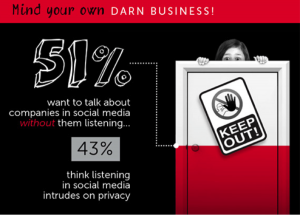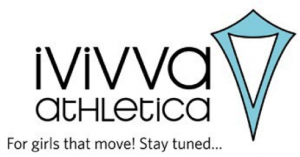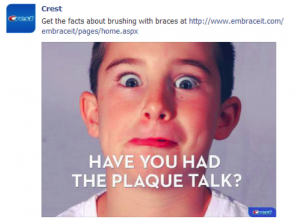Apr 4th, 2013 by Nadia Gunderson
It is hard to believe that it was only a few months ago that COMM 296 started. Time has flown by and, thinking back on the course now, we did so much that has added tremendous value to learning about marketing: the Marketing Plan Assignments, for example.
When we were assigned our groups and met our team members for the first time, I was confident that our team was going to perform well. We were very organized from the get-go and consistently worked hard to deliver our assignments. We tried hard to leverage our strengths and our differences and I was astonished at how successful this approach was for our group. A few of our members were strong writers, and then we also had a member who excelled at digital media, which certainly helped us complete assignment three. The rest of the group supported the completion of our assignments in various ways, with each person contributing effectively. Although not every group member contributed equally on every assignment, overall, each member put in their fair share…and then some!
Although the assignments were complex and required many hours outside of class, the topics were certainly relevant to the course and the concepts studied in class. The effort that we put into our assignments and the nature and relevance of the topics really assisted me in preparing for our midterm.
One issue that I would bring forward for the future is in respect to assignment three. While the Digital Media lab is a great source, unless a group has someone who knows digital media, the assignment would likely be overwhelming and likely not very effective. Perhaps a choice of preparing a presentation or a movie would ensure that all groups have a good chance of learning and delivering a successful result for this assignment.
Overall, I gained a lot from the Marketing Plan Assignments and I was satisfied and pleased with my group, the content of the assignments, and the time and effort we put into each one!

Posted in Uncategorized | No Comments »
Mar 24th, 2013 by Nadia Gunderson
Social media is quickly becoming a marketing norm for many businesses. Social media, notably Facebook, Twitter and YouTube, allow companies to advertise products, raise brand awareness, and interact with current or potential consumers, in a way that was not possible even a few years ago. These days, a Facebook/Twitter/YouTube (or any other channel) link on a company’s webpage is not unusual. But, before we get too ahead of ourselves, Brian Solis raised an alarming concern in a recent blog post. Mr. Solis highlights an increasingly important issue for consumers: “Are businesses invading consumer privacy by listening to social media conversations?”
Not only are companies able to participate in social media conversations with their markets, but they are now also able to “listen” to what consumers are saying without the channel user knowing. This is becoming the new “standard in community engagement”. Is this a good thing? On one hand, being able to ‘eavesdrop’ on consumer conversations allows companies to nurture stronger relationships with customers, encourage loyalty and support, and act upon problems. However, “creeping” into what consumers are saying about a certain brand, product or service where these conversations are not intended for the company is being seen by some as a potential breach of privacy. So, what do you think? Are there boundaries to how businesses should use social media? What would constitute abuse of social media by a business? Share your comments and views.

Posted in Uncategorized | No Comments »
Mar 16th, 2013 by Nadia Gunderson
International Women’s Day (IWD) was celebrated on March 8th. The idea of choosing a day to celebrate women’s rights, and women’s contributions to society came in 1977, when the United Nations General Assembly adopted a resolution calling on member states to proclaim a day for women’s rights and international peace. In Canada, IWD carries a special theme each year. This year’s theme is “Working Together: Engaging Men to End Violence against Women”. Support for and recognition for IWD has grown dramatically over the past decade, and “it has also evolved into a massive day of social media activism, with campaigns popping up throughout the social web”.
One campaign related to IWD that I found especially powerful was the “WeAreEQUALS” Facebook App. EQUALS is an organization comprised of leading charities in the United Kingdom and the United States (such as Save the Children, Oxfam and Women’s Aid) that come together to promote a more equal world. IWD is certainly an important day for EQUALS and in light of the day, the WeAreEQUALS Facebook App was launched. The app “represents an agreement between two friends to equality, presumably between the sexes”. Upon downloading the app, it will ask you to upload an image of yourself and an image of the person who commits to being equal. The app will then merge the two images to create a split frame photo, similar to the ones in the image below. The app encourages you to post and share the image along with your pledge to equality. Examples of pledges include: People will think society is gender equal “when the tears of a woman are tears of joy” or “when the figures actually speak for themselves”.
The WeAreEQUALS Facebook Equalizer App is just one of many media campaigns that support IWD. We need to continue to develop initiatives to promote an environment where women and men are equal in every aspect of society. In North America, we have made progress, but as this year’s IWD theme attests, we still have work to do. In addition, there are many countries around the world where gender equality is still a dream. Although not the only way, the web is a fantastic means to promote the cause, raise awareness and contribute to change. 
Posted in Uncategorized | No Comments »
Mar 9th, 2013 by Nadia Gunderson
I recently read Gemma’s Blog, “How Users Interact with Pinterest”, and since I have had quite a bit of experience using Pinterest both personally and professionally, reading it made me reflect on the social media channel and the questions Gemma raised in her blog.
As Gemma points out, the delicious pictures of food and the dreamy travel destinations lured me into signing up for an account about a year and a half ago. I typically go on Pinterest to browse through great images; I rarely post or re-pin. I became a lot more familiar with the channel last summer when I was an intern for ivivva athletica.
 Ivivva athletica is a new brand that targets young girls who love to dance. The brand was created by lululemon in 2009, and is still in the early stages of raising brand awareness and developing a loyal customer base. As an intern this past summer, I was responsible for managing the brand’s social media channels, Pinterest being one of them. Ivivva was new to Pinterest and I was in charge of growing its presence. Over the course of my internship, I noticed that Pinterest is so small in comparison to other social media channels (eg. Facebook and Twitter), that it is extremely difficult to develop a following.
Ivivva athletica is a new brand that targets young girls who love to dance. The brand was created by lululemon in 2009, and is still in the early stages of raising brand awareness and developing a loyal customer base. As an intern this past summer, I was responsible for managing the brand’s social media channels, Pinterest being one of them. Ivivva was new to Pinterest and I was in charge of growing its presence. Over the course of my internship, I noticed that Pinterest is so small in comparison to other social media channels (eg. Facebook and Twitter), that it is extremely difficult to develop a following.
Based on my interaction and experience with Pinterest through ivivva, and in response to Gemma’s comments on whether or not Pinterest is an effective advertising tool for companies, in my view Pinterest is more effective as an avenue for users to browse images pertaining to their interests rather it is a place for corporate advertising. Personally, I find it refreshing to log onto Pinterest and simply see images…no brand names or logos. Therefore, to answer Gemma’s question at the end of her blog, I believe that currently, there are more effective marketing means for companies than Pinterest. Pinterest users are a niche market and therefore it may be challenging for any particular company to gain a significant following using the channel. Having said this, I am also very aware that not that long ago, people thought computers were a ‘fad’. So, while today Pinterest does not have the reach to be dominant element of a marketing plan, I have no doubt that some companies will soon find a way to capture their customers through this channel, and move Pinterest from a “tool for collecting and organizing the things you love” into a marketing machine.

Posted in Uncategorized | No Comments »
Feb 21st, 2013 by Nadia Gunderson
It’s becoming more and more common to see advertisements or marketing campaigns featuring celebrities. But, how effective is celebrity endorsement? Do sales really increase by having a familiar face on a billboard? I was recently browsing through a magazine and noticed myself stopping my page flipping on certain pages, but not because of a celebrity on the page; rather, I was intrigued by the brand name, the visuals on the page, and the product itself.
I’m not saying that celebrity endorsement is never effective. However, celebrity endorsement alone cannot compensate for a weak brand or ineffective marketing. The ‘star power’ must be accompanied by other elements that contribute to the overall effectiveness of the advertisement. As Richard Burgess highlights in his blog, the celebrity must be “relevant and on-brand”. Companies cannot rely solely on a famous face to sell their product.
The multi-national retail clothing company, H&M, recently launched an advertisement for a men’s underwear line, featuring David Beckham. Yes, the campaign features a celebrity, but in this case, the advertisement had other features that made it effective…at least for me! Check out video below and see if it appeals to you. H&M’s primary customer is young women, so David Beckham shirtless is bound to get the customers’ attention. But that’s not it! The catchy music, the fast pace of the ad, a bit of humor and my personal interest in the H&M brand all played a role in the success of the one-minute clip. H&M understands its primary segment (young women) and what this segment values: hip music, David Beckham and a strong brand.
H&M David Beckham ad
Overall, celebrity endorsement can be an effective complement to other elements in advertising that appeal to the consumer’s affective attitude (such as music). After segmenting the market, a company must understand the values, interests and needs of the target market. So, no, I probably won’t be going into H&M to buy men’s underwear, but that’s beside the point. The company’s ad caused me to think about the H&M brand by effectively utilizing celebrity endorsement, supplemented by fun music, and a fast pace story: all of which align with the company’s target market’s values.
Posted in Uncategorized | 1 Comment »
Feb 5th, 2013 by Nadia Gunderson
There are few things more annoying than scrolling through your Facebook newsfeed only to find it saturated with irritating ads. I often wonder if those ‘in–your-face’ ads encourage customers or turn customers away! Sometimes I scroll right past the ad without registering what the ad is about. I’m sure I am not the only one who thinks this way. There must be a better way for businesses to effectively advertise using social media. Given that social media is becoming a core element of society, it is vital that businesses learn to effectively use the various social media channels avaliable. With the use of simple, highly visual and most importantly, relevant advertisements, businesses could use targeted social media effectively to reach target markets.
Crest sets a great example of how to “cultivate engagement around dynamic imagery” by posting funny, and cute images on their customers’ Facebook newsfeeds. One would typically not be intrigued by a toothpaste ad, but take a look at the advertisements below: the children’s facial expression in the first image jumps off the page and lures the Facebook user to read the ad. To me, advertising is a two-step process: 1. Capture the audience’s attention, and then, 2. Deliver your memorable message. Crest does this successfully: the reader is attracted by the expression on the boy’s face, which then leads the audience to read the text.

In the second image below, Crest captures the audience with an adorable child who has obviously used a bit too much toothpaste. The ad capitalizes on the simple moments in life and targets parents who may have a “too much toothpaste” story to share.

With social media becoming an essential element of any marketing campaign, it is vital that advertisers effectively leverage its power. Crest demonstrates how an advertiser can draw in the audience thereby building a relationship with an ad and a simple statement. I was drawn to their Facebook page and had to stop myself from looking through all their intriguing posts. Kudos for Crest!
Source:
https://www.facebook.com/crest
Posted in Uncategorized | No Comments »
Jan 18th, 2013 by Nadia Gunderson
Known as a company that exudes success by advocating healthy living through the sale of athletic wear, Lululemon faced a brand crisis in November 2007.
Earlier that year, Lululemon launched “VitaSea”, an enticing new fabric that claimed to release minerals and vitamins into the skin upon contact with perspiration. Lululemon claimed that VitaSea would “reduce stress and provide anti-inflammatory, antibacterial, hydrating and detoxifying benefits”. Athletic and health enthusiasts were drawn into Lulu stores to buy VitaSea products.
 Although Lululemon’s manufacturers claimed these benefits, Lululemon had not tested the fabric and later faced questions about whether VitaSea’s benefits were real, thus creating an ethical dilemma for Lululemon: do they try to discount the claims or ‘reconfigure’ them but keep the product on the shelves, or take a different approach?
Although Lululemon’s manufacturers claimed these benefits, Lululemon had not tested the fabric and later faced questions about whether VitaSea’s benefits were real, thus creating an ethical dilemma for Lululemon: do they try to discount the claims or ‘reconfigure’ them but keep the product on the shelves, or take a different approach?
How Lululemon addressed this situation was an opportunity to affirm or a potential risk to the company’s reputation as an ethical operator and trusted retailer.
Soon after the claims were made, Lulu’s (then) CEO, Chip Wilson apologized for the misunderstanding, took full responsibility for the issue and stated that Lululelmon will, in the future, conduct its own fabric testing and not rely solely on the manufacturer’s word.
Chip Wilson’s direct, candid and forthright approach sent a huge message to the market and to Lululemon. An issue that could have called into question Lululemon’s credibility and brand instead confirmed Lululemon’s commitment to ethical dealing in all contexts. Clearly it’s not only high-quality stretchy pants that have taken the company to the top of Wall Street!
Society often criticizes companies for mistakes. However, I believe it is more constructive to analyze how a company responds to its faults and owns up to its mistakes. Lululemon showed how ethics come into play in the face of a marketing dilemma and how an ethical approach is always the right approach.
Article Sources:
http://www.ethicalshopping.com/clothing-accessories/clothes/lululemon-athleticas-seaweed-clothing-contains-no-seaweed.html
http://www.nytimes.com/2007/11/14/business/14seaweed.html?_r=0&ei=5087&em=&en=d9250dddd758769d&ex=1195275600&adxnnl=1&pagewanted=2&adxnnlx=1358313025-gCIJ9TYkoXpFZKOI4cG9qw
Picture Source:
http://www.lululemon.com/community/blog/a-guide-to-lululemon-product-lingo/
Posted in Uncategorized | No Comments »
Jan 6th, 2013 by Nadia Gunderson
Welcome to UBC Blogs. This is your first post. Edit or delete it, then start blogging!
Posted in Uncategorized | 1 Comment »







